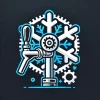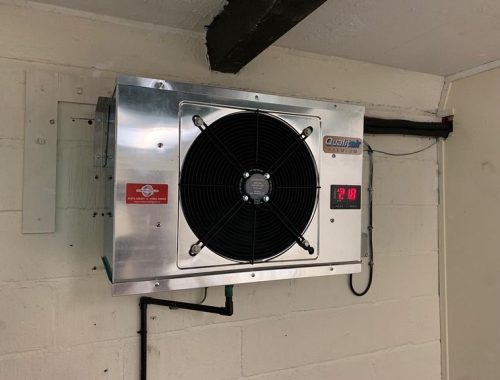Qualitair is a UK-based specialist in cellar cooling and small refrigeration systems.
They offer “Premium” cellar coolers often sold as complete split packages (e.g. Qualitair ICC35M – 3.5 kW system, ICC50M – 5.8 kW, etc., where ICC = Indoor Cellar Cooler, with matching outdoor units). Qualitair units are commonly marketed through distributors like BeerMaster/Climate Center under different names (in some cases known as Blizzard Qualitair or Invicta). They feature stainless steel indoor unit designs and brewery-spec fin spacing (6 FPI). Many Qualitair systems come with a modern electronic control (large touchscreen or Dixell controller) for precise temperature control and energy savings.
Sizes typically cover small to mid-size cellars (around 3.5 kW and 5 kW being popular, which correspond to model QP35, QP50 in some price lists). These are split systems with max 25m pipe runs, designed to maintain 8-12°C (or down to 4°C with modifications).
Common Faults: Qualitair cellar coolers encounter similar issues as others: temperature sensor faults, high pressure trips, and refrigerant leaks are among the most reported. Given Qualitair’s electronic controllers, they do have on-screen error codes. Field experience (as shared by technicians) notes an “E6” error code appearing on Qualitair systems, which has been identified as a communication error between the indoor and outdoor control boards.
This could be triggered by loose interconnecting wiring or a controller fault. Other likely codes on Qualitair/Dixell controllers: E1/E2 for probe errors (similar to generic Dixell codes: E1 = air probe failure, E2 = evap probe failure), HA/LA for temperature alarms, etc. If a Qualitair unit isn’t cooling well, common causes include condenser blockage (leading to high condensing temp and poor capacity), or icing of the evaporator (if the de-ice stat fails or charge is low). Qualitair’s design includes a de-ice thermostat standard, so icing usually means either that stat didn’t cut out or conditions outside spec.
Additionally, Qualitair systems often incorporate factory-fitted options like electric heater elements (for winter heating) and pump-down solenoid as standard in “Premium” variants. Faults with those (e.g. heater stuck on/off or solenoid not operating) can mirror some issues from earlier brands (over-cooling or short-cycling).
Troubleshooting & Fixes: When a Qualitair cooler shows an error like E6 (communication fault), technicians report that simply tightening all wiring connections between the evaporator controller and condenser board can resolve it (loose data cables or power connections trigger comm errors). For sensor errors (E1/E2), replacing the probe is the solution, similar to other systems. Qualitair units have manual HP/LP resets usually – ensure to check those if the compressor isn’t running. The presence of a quick-connect in some Qualitair kits means that improper connection can lead to leaks or restrictions, so check those joints for leaks if performance is low.
If the unit is not holding temperature (but no explicit error code), go through the basics: condenser clean, fans OK, refrigerant properly charged. The Qualitair Premium controller also may have an alarm log accessible – reviewing that can hint at repeated HP cut-outs or probe faults over time.
Manual: Official Qualitair manuals are typically provided upon installation; they may not be widely available online. However, much of the operation uses standard Dixell or LAE controller logic. You can refer to a Qualitair Premium Cellar Cooler User Manual (if available from the installer) or general error code lists for Dixell XR series controllers (since Dixell is mentioned as the controller brand in some product descriptions). Additionally, Qualitair’s support or the distributor’s website might provide PDF manuals on request.
Common Faults & Troubleshooting (Qualitair Cellar Coolers):
|
Issue / Symptom |
Diagnostic Steps |
Technician Fix |
|---|---|---|
|
Error code “E6” on display (Controller alarm, often communication error) |
– Identify controller type: If it’s a Dixell/Invensys controller, “E6” can indicate a communication fault or auxiliary alarm. Qualitair’s touchscreen might show a plain text error or an “E” code. In known cases, E6 was resolved by checking communication lines. – Inspect the interconnecting cable between indoor and outdoor units (if there’s a separate control link). A partially broken wire or interference can trigger comm errors. – Power cycle the system to see if the error clears. If it returns immediately, it’s a persistent fault. If delayed, could be intermittent connection. – Ensure both boards (indoor PCB and outdoor PCB) are powered and functioning – an unpowered board could cause no comm response. |
– Tighten and secure all wiring connections: at the indoor controller, at any terminal blocks, and at the outdoor board. Many times, vibration can loosen screws. Also ensure any data cable shielding is intact. After resecuring, reset power and see if E6 reoccurs. – If problem persists, the issue could be a failed communication module or controller fault. Update or replace the controller PCB if available. Consult Qualitair for a replacement board or firmware update that addresses known comm issues. – In a pinch, some have resolved comm errors by running a new shielded communication cable if the original was damaged. Proper routing away from high-voltage lines can also reduce interference. – Once resolved, monitor that the indoor unit responds properly to commands (e.g., setpoint changes) and that temperatures are updating – confirming communication is restored. |
|
Temperature probe fault (E1/E2) |
– On the Qualitair display, an E1 usually means the air sensor (cabinet sensor) is faulty; E2 might mean the evaporator sensor fault (common in many fridge controllers). If the unit’s display is flashing a temperature error or the temperature reading is obviously wrong (e.g. “-5°C” in a warm room), suspect a sensor. – Locate the sensors: one is typically strapped to the evaporator outlet or coil (de-ice probe), another measures return air. Check if wires are damaged or disconnected. – Use a multimeter to measure sensor resistance and compare to expected values (most likely 5, 10, or 15 kΩ at 25°C NTC thermistors). Open circuit (infinite) or short (0Ω) confirms a bad sensor. |
– Replace the faulty probe with the same type. Qualitair likely uses NTC sensors (often 10kΩ). They may have part codes in manual or you can source an equivalent Dixell probe. Route the new sensor neatly and fasten it where the old one was (air sensor in airflow, coil sensor on evaporator tube). – Reset the controller (power off/on) to clear the error. Verify the displayed temperature now reads plausibly and that the controller engages cooling normally. – If a probe was slightly misreading (not outright failed), the controller might not throw a code but will control poorly. After replacement, calibrate if needed via controller settings (some allow an offset if required). – Keep spare sensors handy; these are inexpensive parts that can save a lot of downtime for any cellar cooler. |
|
Cellar not reaching setpoint (No alarms on display, but temperature remains too high) |
– Setpoint and differential: Double-check the setpoint is correct (some owners accidentally set to 12°C thinking it’s fine but if differential is +/– 2°C, it might allow 14°C actual). Ensure it’s not in a “Economy mode” or similar which might allow temp to drift at certain times. – Check if the unit is running continuously or cycling off prematurely. If it runs non-stop and can’t reach temp, likely capacity issue or fault (like low charge). If it cycles off while still warm, could be a false reading (sensor placement causing short-cycle) or controller misconfiguration. – Feel the evaporator coil: is it evenly cold? If part is warm, maybe partial loss of refrigerant or flow restriction. Check sight glass (if present) for bubbles. – Confirm fans (both evap and cond) at full speed. Some Qualitair may have a two-speed fan or EC fan; ensure performance mode is correct. – Look for high-pressure signs: condenser very hot, maybe pressure cut-outs happening unseen. The controller might not always show an HP trip if it auto-resets, but performance suffers. You might see the compressor cut out if watching closely. |
– Standard remedies: Clean the condenser coil thoroughly and make sure ambient conditions are not extreme. Slightly overcast or reduce heat sources near the condenser if possible. – If suspect low refrigerant (e.g. frost at evaporator beginning, bubbles in sight glass), get a technician to leak test, repair, and recharge the system. Qualitair units pre-charged with nitrogen must be field-charged with R410A or R407C depending on model – ensure the correct refrigerant is used and weighed accurately. – If unit is undersized for a now larger load (more beer kegs, higher ambient), you might need an upgrade – but first rule out mechanical faults. – Adjust controller: Increase fan speed if it was on a low-noise setting and cellar is struggling. Disable any energy-saving mode until temperatures are under control. – If the evaporator is oversized relative to condenser, sometimes evaporator will not get sufficient refrigerant in low load (leading to hunting). In such cases, adding a refrigerant charge carefully (if undercharged) or adjusting TXV superheat might help. Consult Qualitair for proper superheat values. – Also consider cellar conditions: if the cellar has newly added heat loads (like an ice machine exhausting there), remove them – they add unnecessary heat the cooler must remove. High humidity? Consider a dehumidifier or ensure no water on floor adding latent load. |
|
Water leaking in cellar |
– If you see water pooling under the indoor unit, likely the condensate removal is faulty. Qualitair units have a gravity drain or a condensate pump if the evaporator is low. Check the drain tray and outlet – is it clogged with slime or dirt? – If a pump is installed (some premium models include a Little Giant or similar pump), listen if it runs. If silent and reservoir is full, the pump might have failed or lost power. – Also check for excessive frost melt – if the unit iced and then melted, it could overwhelm a small drain. That ties back to defrost issues. |
– Clear the drain line: Use a pipe cleaner or flush to remove algae and debris. Ensure the line has proper fall and no kinks. – If a pump is present and not working, replace the pump or its float switch. Qualitair spares should be available; in the interim, a temporary external condensate pump kit can be rigged to keep cellar dry. – Insulate the drain line if not already – in warm cellars a cold drain can sweat additional water. – Once fixed, also consider if the evaporator fan was off for any period (like after a power outage) – sometimes water blows off the coil when starting up if a lot of condensate was sitting. This is usually a one-time issue. – Keep the cellar cooler running continuously to avoid condensation fluctuations, and maintain cellar door seals (excess humid air entering leads to more condensate production). |
Technical Notes: Qualitair’s emphasis is on energy-efficient control – their premium units might have features like “large touchscreen control” and even connectivity. This is great for monitoring but also means the electronics are a bit more complex. Always follow the manual for setting parameters; incorrect configuration can lead to poor performance or nuisance alarms. For example, some Qualitair controllers allow setting a standby mode or holiday mode – ensure that’s not accidentally activated, raising the setpoint. Also, Qualitair (like other splits) require proper commissioning: vacuum the lines, open the service valves fully (a surprisingly common cause of underperformance is installers forgetting to fully back-seat the service valves after charging, restricting refrigerant flow).
If your cooler was recently installed or serviced, double-check those valves on both indoor and outdoor. Lastly, note that Qualitair has reportedly ceased production of certain models (“Invicta” line), but spare parts remain available – so if a major component fails, you can often repair rather than replace the whole system. Keep handy the contact of a service provider who knows Qualitair or the distributor who sold it (some parts may be under warranty or exchange programs).
(Manual Reference: Qualitair ICC Series Product Guide & Specs)


